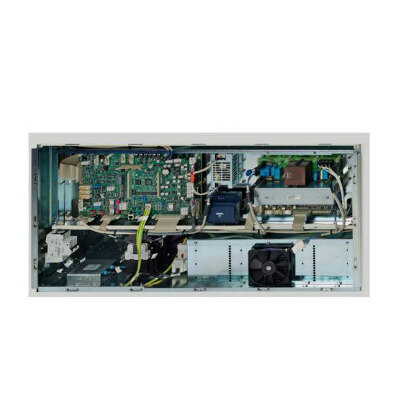Filming Organs and Joints in Real Time Using New MRI Technology
By MedImaging International staff writers
Posted on 30 Sep 2010
Instructing the patient "to hold still” is crucial for patients being examined by magnetic resonance imaging (MRI). It is the only way to obtain clear images for diagnosis. Up to now, it was therefore almost impossible to image moving organs using MRI. German Scientists have now succeeded in significantly reducing the time required for recording images--to just one-fiftieth of a second. Posted on 30 Sep 2010
With this breakthrough, the dynamics of organs and joints can be filmed "live” for the first time: movements of the eye and jaw as well as the bending knee and the beating heart. The new MRI method has the potential to add important information about diseases of the joints and the heart. In many instances, MRI scanning should become easier and more comfortable for patients.
A process that required several minutes until well into the 1980s, now only takes a matter of seconds: the recording of cross-sectional images of the human body by MRI. This was achieved by the FLASH (fast low angle shot) technique developed by German scientists Dr. Jens Frahm and Dr. Axel Haase at the Max Planck Institute for Biophysical Chemistry (Göttingen, Germany). FLASH transformed MRI technology and was largely responsible for its establishment as a most important modality in diagnostic imaging. At present, however, the procedure is still too slow for the examination of rapidly moving organs and joints. For example, to trace the movement of the heart, the measurements must be synchronized with an electrocardiogram (ECG) while the patient holds the breath. Afterwards, the data from different heartbeats have to be combined into a film.
The researchers, working with Dr. Jens Frahm, head of the nonprofit Biomedizinische NMR Forschungs, GmbH (Gottingen, Germany), now succeeded in additionally accelerating the image acquisition process. The new MRI method developed by Dr. Frahm, DR. Martin Uecker, and Dr. Shuo Zhang reduces the image acquisition time to 20 milliseconds, making it possible to obtain "live recordings” of moving joints and organs at so far inaccessible temporal resolution and without artifacts. Filming the dynamics of the jaw during opening and closing of the mouth is just as easy as filming the movements involved in speech production or the rapid beating of the heart.
"A real-time film of the heart enables us to directly monitor the pumping of the heart muscle and the resulting blood flow--heartbeat by heartbeat and without the patient having to hold the breath,” explained Dr. Frahm. The scientists believe that the new technique could help to improve the diagnosis of conditions such as coronary heart disease and myocardial insufficiency. Another application involves minimally invasive interventions, which, due to this discovery, could be carried out in the future using MRI instead of X-rays. "However, as it was the case with FLASH, we must first learn how to use the real-time MRI possibilities for medical purposes,” said Dr. Frahm. "New challenges therefore also arise for doctors. The technical progress will have to be ‘translated' into clinical protocols that provide optimum responses to the relevant medical questions.”
To achieve the breakthrough to MRI measurement times that only take very small fractions of a second, several developments had to be successfully combined with each other. While still relying on the FLASH technique, the scientists used a radial encoding of the spatial data that renders the images insensitive to movements. Mathematics was then required to reduce the acquisition times further. "Considerably fewer data are recorded than are usually necessary for the calculation of an image. We developed a new mathematical reconstruction technique which enables us to calculate a meaningful image from data which are, in fact, incomplete,” explained Dr. Frahm.
In the extreme case, it is possible to calculate an image of comparative quality out of only 5% of the data required for a normal image, which corresponds to a reduction of the measurement time by a factor of 20. As a result, the scientists have accelerated MRI from the mid-1980s by a factor of 10,000.
Although these fast MRI measurements can be easily implemented on current MRI devices, something of a bottleneck exists when it comes to the availability of sufficiently powerful computers for image reconstruction. Physicist Dr. Uecker explained, "The computational effort required is gigantic. For example, if we examine the heart for only a minute in real time, between 2,000 and 3,000 images arise from a data volume of two gigabytes.”
Dr. Uecker consequently designed the mathematical process in such a way that it is divided into steps that can be calculated in parallel. These complicated calculations are carried out using fast graphical processing units (GPUs) that were originally developed for computer games and three-dimensional visualization. "Our computer system requires about 30 minutes at present to process one minute's worth of film,” said Dr. Uecker.
Therefore, according to the scientists, it will take a while until MRI systems are equipped with computers that will enable the immediate calculation and live presentation of the images during the scan. In order to minimize the time their technology will take to reach practical application, the Göttingen researchers are working in close cooperation with the company Siemens Healthcare (Erlangen, Germany).
The research findings were published online August 27, 2010, in the journal NMR in Biomedicine.
Related Links:
Max Planck Institute for Biophysical Chemistry
Biomedizinische NMR Forschungs
Siemens Healthcare














